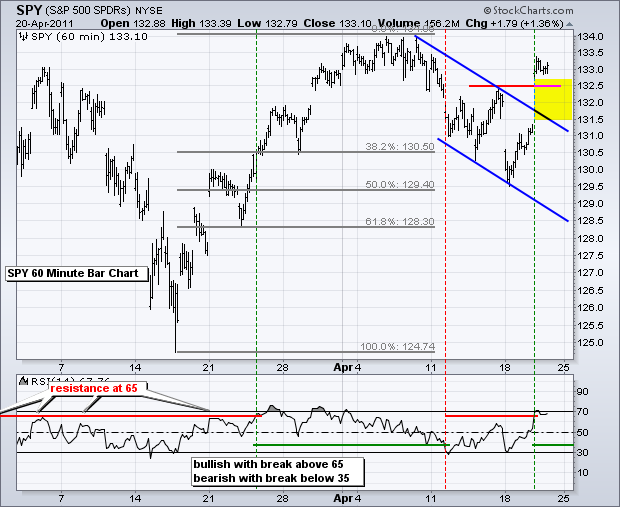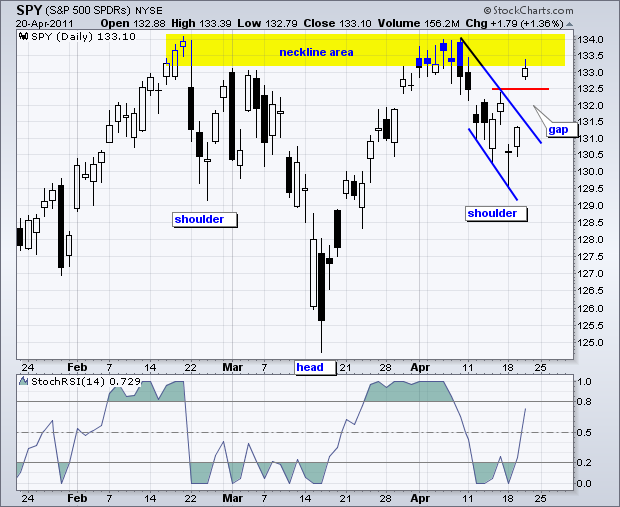The short-term trend is now up with a flag breakout and big gap. On the daily chart, an inverse head-and-shoulders is taking shape now that the right shoulder low has formed a reaction low near the left shoulder low. The neckline resistance zone resides around 133-134, which is where SPY is currently. After a 2.2% surge the last two days, the ETF is already short-term overbought. With resistance at hand, we could see a little backing and filling to work off this overbought condition.
On the 30-minute chart, SPY forged a big gap down on Monday and a bigger gap up on Wednesday. The bears placed big bets on Monday, but it looks like the bulls countered with an "all in". There is now a gap zone around 131.5-132.9 that acts as the first support zone. This is a bit big though. I would mark a support zone around 132-132.5, which was the prior resistance zone. A move below 132 would call for a reassessment of this breakout. RSI surged above 65 to confirm the breakout in SPY. Bull range support is now set at 35.

Key Economic Reports/Events:
Apr 21 08:30 Jobless Claims
Apr 21 10:00 Philadelphia Fed
Apr 21 10:00 Leading Indicators
Charts of Interest: Tuesday and Thursday in separate post.
-----------------------------------------------------------------------------
This commentary and charts-of-interest are designed to stimulate thinking. This analysis is not a recommendation to buy, sell, hold or sell short any security (stock ETF or otherwise). We all need to think for ourselves when it comes to trading our own accounts. First, it is the only way to really learn. Second, we are the only ones responsible for our decisions. Think of these charts as food for further analysis. Before making a trade, it is important to have a plan. Plan the trade and trade the plan. Among other things, this includes setting a trigger level, a target area and a stop-loss level. It is also important to plan for three possible price movements: advance, decline or sideways. Have a plan for all three scenarios BEFORE making the trade. Consider possible holding times. And finally, look at overall market conditions and sector/industry performance.

Key Economic Reports/Events:
Apr 21 08:30 Jobless Claims
Apr 21 10:00 Philadelphia Fed
Apr 21 10:00 Leading Indicators
Charts of Interest: Tuesday and Thursday in separate post.
-----------------------------------------------------------------------------
This commentary and charts-of-interest are designed to stimulate thinking. This analysis is not a recommendation to buy, sell, hold or sell short any security (stock ETF or otherwise). We all need to think for ourselves when it comes to trading our own accounts. First, it is the only way to really learn. Second, we are the only ones responsible for our decisions. Think of these charts as food for further analysis. Before making a trade, it is important to have a plan. Plan the trade and trade the plan. Among other things, this includes setting a trigger level, a target area and a stop-loss level. It is also important to plan for three possible price movements: advance, decline or sideways. Have a plan for all three scenarios BEFORE making the trade. Consider possible holding times. And finally, look at overall market conditions and sector/industry performance.

About the author:
Arthur Hill, CMT, is the Chief Technical Strategist at TrendInvestorPro.com. Focusing predominantly on US equities and ETFs, his systematic approach of identifying trend, finding signals within the trend, and setting key price levels has made him an esteemed market technician. Arthur has written articles for numerous financial publications including Barrons and Stocks & Commodities Magazine. In addition to his Chartered Market Technician (CMT) designation, he holds an MBA from the Cass Business School at City University in London.
Learn More






